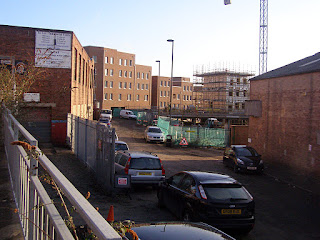I nipped out to post a letter – yes, crazy old man, I still write (or type, my handwriting is so bad) letters and use stamps.
It was a day of low grey to charcoal skies and sudden clear blue horizons and streaming window panes glinting with beads of rain.
Battlefield lay across the street. Suddenly it looks fantastic. It is as if the trees have suddenly broken free and stand taller than I have ever seen them.
After the rain.
I went for a stroll and took a few photographs. Beside the old paint factory site I heard warblers calling. Garden Warblers? I shall have to check. Very musical in a limited way. Then Chiff Chaffs, another woodland species. People came and went and only one cyclist tried to break the land speed record.
Footpath no more?
The old footpath down to Shieldfield Lane is still blocked. Will it be re-instated? It would serve students in the new halls of residences with a short cut to their nearest Post Office and off licence.
Wood or Garden Warblers?
I began this blog to try to place on record something of a counter weight to the storyline being pumped out by the Council and prospective privatisers of open space* that this was a 'threatening place' rather than a resource and green lung for a city, an important link in a chain of green spaces leading from the distant Green Belt through the city to the banks of the Tyne. Despite the threats, the reality is the ground beneath is infill and so cannot accept the kind of developments some hoped to put in place. The original threat was to build offices over the former paint factory site and use the green space as a car park for – wait for it – thirteen hundred cars. Tarmac to replace grass.
Though I deplored the tree felling that preceded it, the creation of the cycle way does I think remove many threats, though some remain. I felt the tree felling went too far and the subsequent re-planting too small in scope. Ten years seem to have been a long time in this transformation. I think it safe to say a new way of looking at the environment and the growth of green awareness have played a part. The 'big business is good' way of doing things has left people cold, thankfully.
The space is well used. It could be more so, particularly as a venue for large out door events in summer. Joggers and dog walkers (mostly very responsible), parents with small children and just strollers going to the shops, use the space well. A friend pointed out how some land could be used to create a green way down to the Lower Ouseburn behind the old paint factory, ducking beneath the bridges to Stepney Bank. Combined with another cycle route, this has much to offer. In the last decade much has happened in Lower Ouseburn and the creation of a 'student city' around Portland Road would seem to suggest a synergy might be easily made.
Meanwhile the trees thrive, the migrant birds are here for summer and the days are long.
Slideshow
here. (Off site link)
* The space I call Battlefield is not official designated as 'Open Space'. It could, following recent legislation passed by the previous Coalition government, be sold off in whole or in part. It might be possible to build on parts of the site, though much was created by infilling part of the Lower Ouseburn dene by an equally short sighted Council in the 19th century.

































